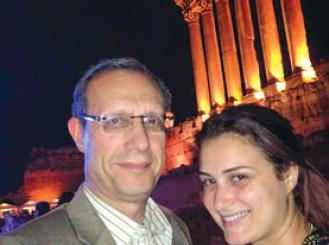Oct 28, 2014
An interview with Nagi S. El Saghir, MD, FACP, Immediate Past Chair ASCO International Affairs Committee
If you are looking for Nagi S. El Saghir, MD, FACP, of NK Basile Cancer Institute and the American University of Beirut Medical Center, Beirut, Lebanon, after a medical conference, an awareness raising event, or a formal dinner, chances are you’ll find him on the dance floor. According to Dr. El Saghir, his passion for dancing comes from the feelings of happiness and connection the art creates.
AC: When do you find opportunities to dance?
Dr. El Saghir: I am neither a professional dancer nor a regular amateur at dancing. However, I do like to approach life events, including professional relationships and cancer-related events, with a hopeful, cheerful outlook. In addition to parties and weddings with family and friends where there is dancing, I enjoy when there is dancing at events like graduations, oncology conferences, and Best of ASCO® gala dinners. I like to add a cheerful flavor to our breast cancer awareness campaign events by adding ceremonies and dancing to them. You should see the positive impact this shared experience has on people, and how long they keep talking about it.
I have never taken any formal lessons. I usually make my own steps. I always say that dancing comes naturally to people. Oriental and belly dancing movements are probably embedded in the DNA of people from the Middle East. Belly dancing is a beautiful art requiring great skill, and in this part of the world, men and women dance in that style. It is easy to learn. People dance it in parties and weddings the way people dance to rock-and-roll in the United States and Europe. I have friends who are masters of the art of belly dancing and they calculate and enjoy every step they make. The dancers’ movements with their body, arms, and legs all flow with the music.
AC: Can you define what you enjoy most about dancing?
Dr. El Saghir: Dancing, like music, is a universal mind and body language that requires both concentration and spontaneity at the same time. I think music and dance make people put aside their fears and troubles and live their happier emotions to the fullest. Even when we listen or dance to sad music, it helps us clear our inner soul of its complications. We put aside our tension and replace it with relaxation. Our oncologists and nurses seem so happy when we have a gala dinner with music and dancing after a long CME meeting. Dance may even reduce oncologist burnout (we need a study to prove that!).
AC: What is your favorite music to dance to?
Dr. El Saghir: Throughout my training and professional years, I have experienced European, American, and Middle Eastern Arabic music and dancing. Every one of them has unique aspects. I think one can experience the songs best when one understands the lyrics. The Beatles were great for that. French classics, American country songs, and Middle Eastern songs are really great for that also. Middle Eastern Arabic songs are often first class poetry and that is a wonderful aspect—dancing to those songs invites lots of body language.
AC: What kind of dance and music are popular in or unique to Lebanon?
Dr. El Saghir: Apart from Middle Eastern dancing and belly dancing, Lebanon is also known for its folkloric dance called dabkeh. The dabkeh is a group dance where people hold their arms together in rows of five, 10, or more people, and perform balanced moves on their feet to the front, back, and sides, while raising their feet and tapping on the floor with different strengths, all done in coordination with the rhythms of special dabkeh music and songs. Also, people in Lebanon have been exposed to various civilizations who passed through the region throughout the ages, and also have traveled all over the world. In their parties and dance clubs, people listen and dance to international music and songs from rock-and-roll to all other modern so-called Western music. Lebanon has regular abundant summer music festivals like the Baalbeck International Festival. Lebanese singers, poets, and composers are very famous on the local, Arab, and international scenes.
AC: What other hobbies do you enjoy when you aren’t busy with your professional responsibilities?
Dr. El Saghir: People say that I am a good singer. I sing to my kids, especially when they were younger, and in the car when I’m driving. I love and am good at photography. I love to take pictures of nature, of people, and especially at the conferences I attend. I have a great collection of pictures from ASCO Annual Meetings, which I’ve attended almost every year since I became a member in 1984, which I hope to publish one day. Also, I love writing. I contribute last-page social articles in the local weekly magazine Al-Afkar, and I wrote an awareness and educational book on breast cancer in Arabic.
AC: Does your family share your love of dancing and music?
Dr. El Saghir: They all enjoy their own creative and athletic activities. My wife, Safaa, is a gifted painter. Bassem, my youngest son, takes music lessons and plays basketball at the International School in Beirut. He used to do lots of dancing at parties when he was a little kid, but now he is growing up and more shy, at least when I am around! My older son, Saeed, is a college student at the University of Michigan Ross Business School, and he is a regular cross-country and marathon runner. My daughter Yasmeen works with the United Nations High Commission for Refugees in Beirut and practices yoga. Malak, my younger daughter, studies psychology at Delta College in Bay City, Michigan, and she always has her iPod plugged into her ears.

